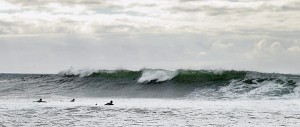Published in The Daily Nexus: http://www.dailynexus.com/2009-02-17/germs-infest-sb-waters/
By Casey Capachi
The stormy weather soaking Santa Barbara County may have brought some nice swell with it, but with the rain comes bacteria-laden run-off and the threat of ocean-borne illnesses.
While the rain and wind keeps most indoors, surfers suffering through what has been a mostly flat winter have been quick to take advantage of the beach breaks off the coast of Isla Vista. But with dirty run-off from the storms dumping straight into the ocean, many surfers will inevitably catch more than waves during their stints in the ocean.
Colds and sinus infections are most common, Sandy Lejeune, chair of the Santa Barbara Surfrider Foundation, said, but more serious illnesses can and have occurred as a result of runoff.
“It’s hard to keep surfers out of the water when there is swell running,” Lejeune said. “But many surfers have experienced illnesses: colds, sinus and ear infections. Although it does not occur often, there have been cases of surfers contracting hepatitis from being in the ocean.”

With all drains eventually leading to the ocean, rainwater collects a litany of contaminants – including oil residue, trash and bacteria – on its way through the streets and onto the beaches. Kira Redmond, executive director of Channelkeeper, an organization that tests the local waters to ensure public health, recommends that surfers note the increased pollution and wait out bad weather before hitting the beaches.
“Anytime after a rainstorm you are going to find an increase in water pollution,” Redmond said. “If you’re swimming or surfing you should be careful because the ocean becomes contaminated with waste washed away with the rain that contains bacteria. Staying out of the water for three days after a rainstorm is recommended.”
According to Redmond, Isla Vista’s beaches are at a particularly high risk for contamination.
“Isla Vista has been affected by the storms and run-off because it is a densely populated area,” Redmond said. “The most populated and most affected areas will be in South County like Goleta and Carpinteria. Also, agricultural areas in the north will have waste washed away from their farms.”
Adding to the polluted mix is run-off from Santa Barbara’s recently burned mountainsides, Redmond said. This summer’s Gap Fire and November’s Tea Fire in particular have burned vegetation, which would otherwise serve as a filter for nutrients from rushing into water systems. Additionally, hydromulch used to encourage new vegetation in the burn areas has been shown to contain pollutants, which can wash into the seas during storms.
“Fires are a big source of water pollution,” Redmond said. “You’ve got a lot of ash that washes into the creeks,” Redmond said. “To help the county used hydromulch to stop erosion but it contained little bits of plastic, foil, and other trash.”
Willie Brummett, an environmental health specialist with Santa Barbara County, acts as a watchdog for local run-off pollution, checking places like construction sites to make sure contractors do not drop their waste down drains.
He said that the main contaminant of I.V. beaches is the bacteria from trash discarded by locals. However, Brummett says that I.V. is less polluted than other areas, thanks to the wetland that keeps many run-off pollutants from reaching the water.
“The area around Goleta Beach has a wetland that filters pollutants,” Brummett said. “Trash goes through a screen prior to entering Goleta Beach. This does not treat bacteria but mostly stops red cups from entering the ocean.”